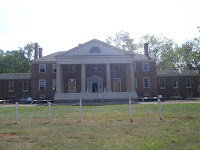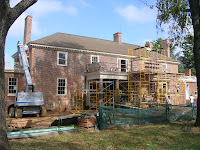 served as the Secretary of State under Thomas Jefferson. He is also known as the "Father of the Constitution" and architect of the Bill of Rights. President Madison was also an avid reader and collector of books. It is said that he asked friends to bring him books from wherever they traveled. And he wanted them in their original languages. It known that he could translate at least Hebrew, Greek and Latin. It could be that he knew other languages, too. It's thought that he may have had over 4000 books in his library. It is in that upstairs library that he drafted our Constitution.
served as the Secretary of State under Thomas Jefferson. He is also known as the "Father of the Constitution" and architect of the Bill of Rights. President Madison was also an avid reader and collector of books. It is said that he asked friends to bring him books from wherever they traveled. And he wanted them in their original languages. It known that he could translate at least Hebrew, Greek and Latin. It could be that he knew other languages, too. It's thought that he may have had over 4000 books in his library. It is in that upstairs library that he drafted our Constitution.Dolley Madison was the first wife of a president to be called First Lady. She was known to be a fashionable and politically astute hostess, holding parties and dinners.
The land upon which Montpelier rests was purchased by President Madison's grandfather Ambrose in 1723. Ambrose built a small homestead with slave quarters about a third of a mile from where the president's house currently sits. G'father Ambrose named his property, Mount Pleasant. It was James Madison, Sr. who built the mansion known as Montpelier in 1760.
Since Mr. Madison, Sr.'s first building of Montpelier in 1760, the structure has undergone many, many changes. Originally, the house was 6000 square feet, not a
 small home at all. Once the president married in 1794, he decided the home needed a couple of additions - one on either side of the original building. One addition was for his mother; the other was to accommodate his new wife and her son from a previous marriage. President Madison also added terraces to the roofs of these additions and large porch to the back of the home. Upon the completion of these additions, the house was now double in size - 12,000 square feet.
small home at all. Once the president married in 1794, he decided the home needed a couple of additions - one on either side of the original building. One addition was for his mother; the other was to accommodate his new wife and her son from a previous marriage. President Madison also added terraces to the roofs of these additions and large porch to the back of the home. Upon the completion of these additions, the house was now double in size - 12,000 square feet.A couple of interesting trivia points: there is a Cedar of Lebanon just to the side of the mansion. It was given to
 President Madison by General Lafayette. Also, President Madison had a temple built in 1811 that was for meditation and reflection. He wanted a place of quiet to share with his guests. But, being the practical man he was, there was an icehouse built under the columns so that he could serve his guests chilled refreshments!
President Madison by General Lafayette. Also, President Madison had a temple built in 1811 that was for meditation and reflection. He wanted a place of quiet to share with his guests. But, being the practical man he was, there was an icehouse built under the columns so that he could serve his guests chilled refreshments!After the death of President Madison at Montpelier in 1836, Dolley lived in the home, alone, until 1844 when she sold it. It is said that Dolley was extremely lonely in the house and moved back to Washington, DC where she enjoyed the busy social life she had had in previous years there. However, upon her death, Dolley was buried at Montpelier alongside her beloved James.

From the time Dolley sold the house in 1844, until its purchase by the duPont family in 1901, there were 6 owners of the house. Some families lived in it as short a time as a year, others as much as ten years.
William & Annie duPont bought the home in 1901 and it remained in their family until it was transferred to the National Trust in 1984 as bequeathed by Marion duPont Scott. Ms. Scott was the daughter of William & Annie and had grown up in the home. She was given the house upon the death of her parents and her brother was
 left a home in Delaware near the family business. Ms. Scott was a horsewoman and went on to raise award winning horses, three of which are buried on the property. Two of these horses were sired by Man O'War.
left a home in Delaware near the family business. Ms. Scott was a horsewoman and went on to raise award winning horses, three of which are buried on the property. Two of these horses were sired by Man O'War.During the duPont years, the house once again underwent construction. The duPonts added a second story to both of the additions President Madison had built as well as built out the back of the home. Once finished, the duPont Montpelier was almost 37,000 square feet! They had also refinished the outside of the home in stucco and completely renovated the inside of the home as well. This picture is the last remaining addition from the
 duPont years.
duPont years.When Marion duPont Scott bequeathed Montpelier to the National Trust it was with the condition that the home be restored to what it was while James & Dolley Madison lived there. In 2003, that restoration began and is still ongoing today. It is an amazing, tedious, detailed work. It is expected to be completed by March, 2008. That is only the outside and inside structural restoration. Restoring decorations, furniture, paint, wallpaper, etc., will not begin until 2009 as the interior structural work must "cure" before anything can be done to the walls.
Because of the many changes made to the house by the duPont family, it is difficult to know how some of the rooms were originally fashioned. It is through old letters, newspaper clippings and just a few pictures that
 they are able to do this. One very neat story is that finding a mouse nest helped to know whether some wallpaper shreds were from the Madison home or the It was very interesting to learn how the archaeologists and restoration experts are able to recreate the original home. Because the mouse used a small piece of a letter written by President Madison in making its nest as well as the wallpaper shreds, it was determined that the mouse
they are able to do this. One very neat story is that finding a mouse nest helped to know whether some wallpaper shreds were from the Madison home or the It was very interesting to learn how the archaeologists and restoration experts are able to recreate the original home. Because the mouse used a small piece of a letter written by President Madison in making its nest as well as the wallpaper shreds, it was determined that the mouse  nest was a Madison mouse nest and not a duPont mouse nest! So, everything found in the house is used in the restoration of this beautiful home.
nest was a Madison mouse nest and not a duPont mouse nest! So, everything found in the house is used in the restoration of this beautiful home.There is also a formal garden area. The gardens were begun during the Madison era, but were enlarged upon by the duPonts. Also found on the property is the Landmark Forest. It is the largest uncut forest in the eastern United States. Madison wanted to keep some of the land untouched.
This national treasure will continue to change over the next few
 years as the restoration process continues. I encourage everyone to take time to visit Montpelier. It is fascinating to walk where one of our Founding Fathers lived and died.
years as the restoration process continues. I encourage everyone to take time to visit Montpelier. It is fascinating to walk where one of our Founding Fathers lived and died.Tomorrow we are going to drive along more of Skyline Drive. Looking forward to that. Unfortunately, I am having trouble uploading pictures to our Webshots site. I hope that problem resolves itself soon.
Take care of one another. Please keep in touch. Until the next time . . .

No comments:
Post a Comment